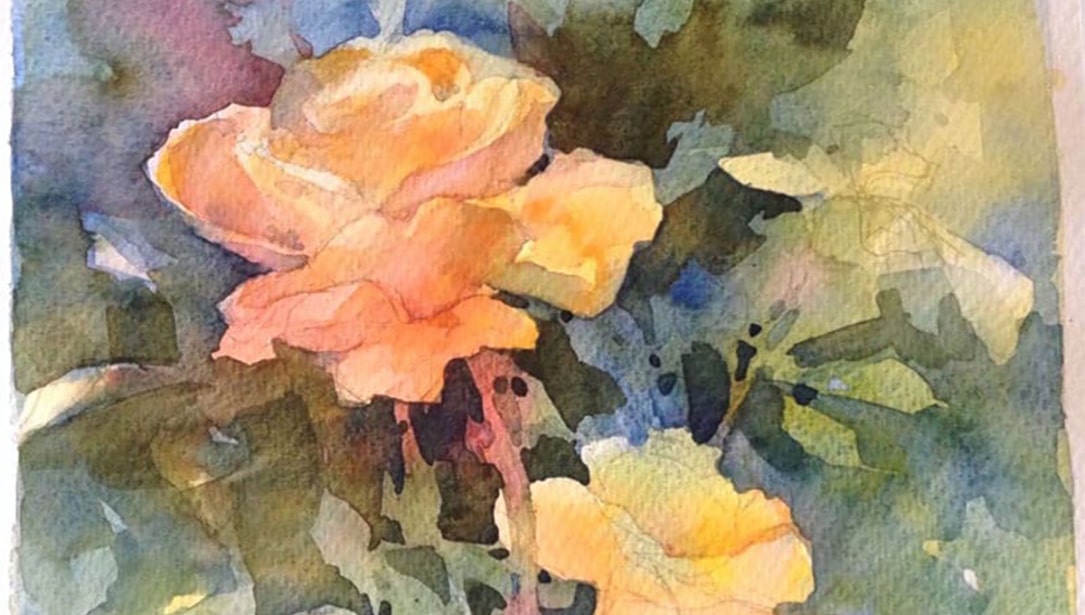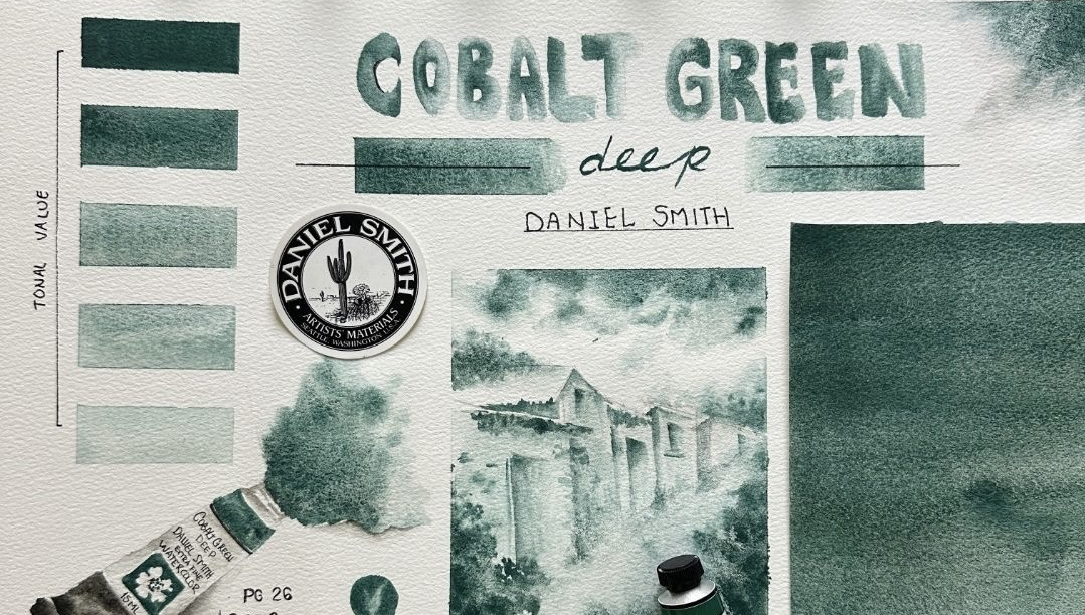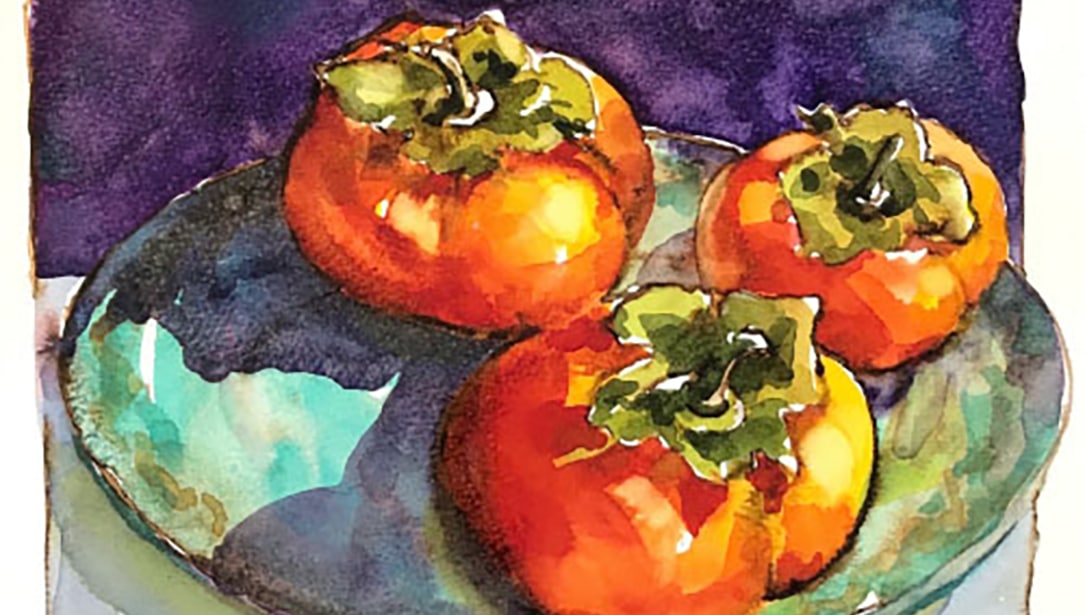Painting a successful watercolor doesn’t have to be difficult or frustrating. Once you have mastered the most integral part of the process, you will have a fresh and luminous painting every time. The wash is the basis for each of your paintings. It is color laid into an area usually too big to accomplish with only one stroke. Skies, backgrounds, and any space requiring an application of smooth or integrated color can be achieved by a successful wash.
There are four basic washes:
- Flat wash – useful for skies and any area requiring smooth color with no visible brush strokes.
- Graduated or gradient wash – great for skies, soft transitions of light to dark or vice versa, used often in Asian watercolor and prints.
- Variegated wash – used when you need a transition of one color to another, like when painting a sunset where the color in the sky transitions from blue to orange.
- Wet-into-wet wash – many artists’ favorite wash for playing with colors to see how they react with each other. Apply color by dropping it into a wet surface and allowing adjacent colors to mingle and show off their own individual properties.
Along with these four basic washes, there is also a glaze, which is a flat wash done with very diluted pigment. Thin, transparent layers are applied over an existing DRY wash. Knowing the properties of your pigments will help ensure a clean, translucent effect. Visit our Resources section to read your favorite Color Stories or review properties listed on our color charts. You can also make your own swatch chart to see how each pigment will appear on a piece of watercolor paper.

Here’s how to achieve each type of wash:
(1) Flat wash
Tape an eighth of a sheet of 300# watercolor paper (or 5X7” sheet of 140#) to a backing board and place on a slant using a two or three-inch binder under it for support. Mix up a puddle of pigment much larger than you think you will need. Wet your paper (I use #6 Isabey 6235 series squirrel hair cat’s tongue filbert wash brush). Do not wet it to the point of it being sopping wet (that will cause the wash to dry unevenly and may create runs and backwashes), but equally wet over the entire surface.
Load your brush with pigment and pull it evenly across the top of the paper. Begin on whichever side is most comfortable for you, but remember to start at the same edge each pass. When you reach the opposite edge and have completed my first stroke, repeat this step by reloading the brush and continuing with the next stroke just below the one above it. Gravity will help pull the color down, and if your paper is not too wet, your wash will begin to even out as you come to the bottom of your paper.
Pick up any excess pigment and/or water at the edges of your wash with a slightly damp, pointed round brush or paper towel, being careful not to disturb your wash. When the shine has left your paper, you may set it flat to dry, being careful not to leave any excess moisture on your edges or on your tape.
Some artists like to do flat washes on dry paper, and you may wish to try this technique. It is the exact same procedure as described above, except you do not wet your paper first, and you must mix a puddle that is a little thinner (more water and less pigment than above) to ensure a consistency and smoothness to your wash. With each subsequent stroke, you will also want to catch the bead of water and pigment that will form at the bottom edge of each prior stroke.
With both wet and dry paper, don’t forget to reload your brush before each stroke or pass across your paper.
Once completely dry you should have a solid, clean, stroke-free wash. Be careful not to use too much pigment. It is easier to do a second wash if greater intensity or darker value is desired. Trying to get it too dark/deep with the first pass can result in streaky, uneven washes.
(2) Graduated or gradient wash
Providing an ideal background for most landscapes, the gradient wash may be created from top to bottom, then turned upside down for use. A graduated wash typically progresses from dark to light. Most artists prefer to achieve this wash by beginning with dry paper, but I find I can accomplish it just as easily with damp paper. Begin with dry paper taped to a backing board and set at a slant as you did with the flat wash. Mix a large puddle of pigment – not too thick – and remember to mix your pigment with the water to eliminate particles and dark specks in your wash.
Begin with a loaded brush, enough to leave a bead of color/liquid at the edge of the completed stroke. Reload your brush after every pass, and then touch the bead to begin the next stroke, going the entire way across the surface of your paper. Continue in this manner about one fourth of the way down your paper, then begin adding water to your wash with every other stroke. You want to dilute your puddle of pigment so that it is progressively less pigment and more water. When you reach the area you want to be mostly (or all) water, simply use clear water and no pigment. The pigment will want to flow downward, so be aware of the amounts of liquid you are applying. Be sure to clean off any excess from your edges.
This wash may take a couple of attempts to perfect, but once you do, you will be able to use it in many different ways. For example, try turning your paper and doing the wash horizontally, then turn it vertically to create the look of light coming from one side of the painting. Don’t be afraid to try this wash on damp paper. You will require slightly less water, and it’s a good idea to control the flow with your free hand.

(3) Variegated or blended wash
Mix two puddles with a different hue/pigment in each – I prefer using two transparent colors. This wash is best applied on damp (not overly wet) paper. Prepare your paper on a slant and dampen it with clean, cool water.
Begin a variegated wash with the lightest color, starting at the top. Remember to apply each stroke from the same direction, and to reload your brush with pigment for each pass. You will want to move quickly – if the pigment is moving too rapidly down your paper, control the flow with your free hand by slightly lifting the downhill edge of your board. As you approach the center of your wash, turn your board/paper upside down so that you can apply your color from the opposite direction you began with your first hue.
Repeat the steps above, ending with your second color about an inch or so above the first. Wipe away any excess color/water from the edges of your wash. Set it flat to dry, ensuring you do not have a puddle in the center of your wash. If you do, take a thirsty round brush (one not loaded with either pigment or water) and using the point, carefully allow it to extract the excess. Notice how beautifully the two pigments join in the center of your paper? This wash can create a gorgeous sunset when Quinacridone Sienna and either Phthalo Blue (GS) or Indanthrone Blue are used together in a variegated wash. Begin with the blue at the top and notice the glowing neutral where the two hues join.
(4) Wet into wet wash
This is the “play-time” wash. Whenever I am painting a highly detailed piece, I often will just need to take a break and splash around. I feel like a little kid again, playing in the water! Wet into wet washes can take you places you didn’t know existed! Tape down a quarter (or eighth) sheet of 300# paper. Use a ruler and a #2 pencil to create a series of either rectangular and/or square shapes, leaving at least a half-inch space between each shape. Mix your puddles using two different pigments of your choice.
Working from the top of your paper to the bottom on a flat surface, wet one of your shapes. Be careful not to use too much water – you want it fairly damp, but not sopping wet so that there is a big puddle of water in the shape. If you do put in too much water, use your thirsty brush to extract the excess. Load your brush with one of the pigments. Using the tip only, touch your brush to one side of the shape you have dampened. If you have used enough water, the paper should pull the pigment off your brush – this is called “dropping in.” Once you are satisfied with the amount of this color in your shape, clean your brush and load it by dipping into the next pigment puddle. Repeat step one above, ensuring that you drop the color NEXT to the first one, or on an opposite side of your shape. Do not drop it on top of the previous color. Now, sit back and watch the magic happen. Depending on which pigments you have chosen, you will see them seek each other out and mingle. You can encourage the process by lifting and tilting your paper/backing board. When the shine has disappeared from the paper, you can proceed to your next shape. Try it with two different pigments.

Try different combinations, such as three different pigments or two complementary colors (opposite one another on the color wheel). Try three analogous colors and one complementary color (a color opposite one of your analogous colors on the color wheel). The possibilities are endless and limited by only your imagination. Once you have mastered these four basic washes, you can paint anything in watercolor! The most important thing is that you enjoy the process and remember that no matter where you are in your watercolor journey, take time to splash around! It’s about process, not perfection.







